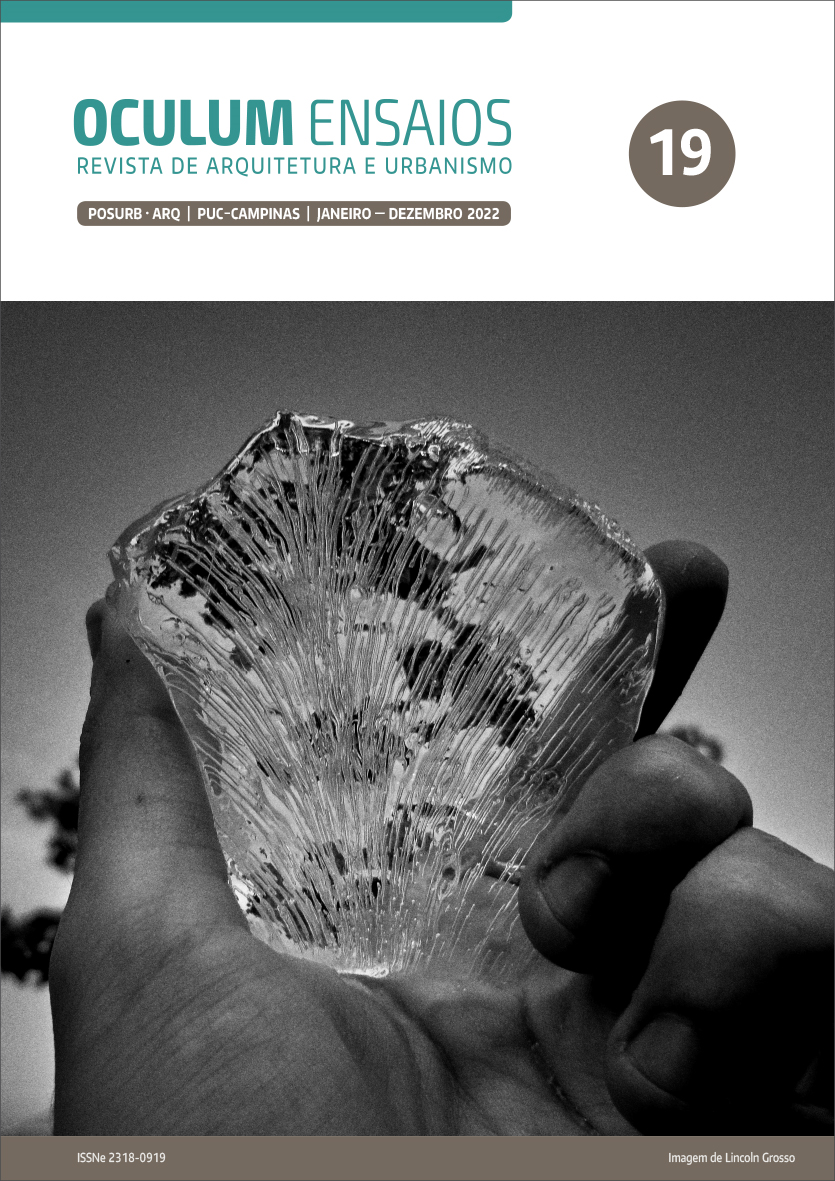Urban morphology, landscape, and “Genius Loci”
DOI:
https://doi.org/10.24220/2318-0919v19e2022a4903Keywords:
Morpho-typology, Landscape, Urban heritage, PreservationAbstract
This article is about the relationship between the concepts of urban morphology, landscape, and “genius loci”. The last two concepts have been frequently employed in the issues related to heritage conservation. The first concept – urban morphology – has many applications, and one of them is on the conservation, mainly in the analysis of the places, of urban tissues that compose the city, and where the permanency
(or continuity) is detected and observed in the plots or in the volumetry of buildings, and other manifestations. However, the urban morphology has many investigative lines. This article is about them and whether they dialogue with each other or not, and how they could be compatibilized with the concepts of landscape and “genius loci”. In summary, we aim to apply these concepts in the issues related to urban heritage conservation.
Downloads
References
CALABI, D. Parigi anni venti. Marcel Poëte e le origini dela storia urbana. Venezia: Marcilio, 1997. p. 76.
CANNIGGIA, G.; MAFFEI, G. L. Composizione architettonica e tipologia edilizia I: lettura dell’edilizia di base. Venezia: Marsilio, 1979.
CANNIGGIA, G.; MAFFEI, G. L. Composizione architettonica e tipologia edilizia II: il progetto nell´edilizia do base. Venezia: Marsilio, 1984.
CATALDI, G.; MAFFEI G. L.; VACCARO, P. Saverio Muratori and the Italian school of planning typology. London: Urban Morphology, v. 6, n.1, p. 3‐14. 2002. Disponível em: http://www.urbanform.org/online_unlimited/pdf2002/200261_3-14.pdf. Acesso em: 5 abr. 2020.
CHOAY, F. O urbanismo: utopias e realidades, uma antologia. São Paulo: Perspectiva, 2010.
CONZEN, M. R. G. Alnwick Northumberland: a study in town-plan analysis. Londres: Institute of British Geographers Publication, 1960.
COSTA, S. A. P.; NETTO, M. M. G. Fundamentos da morfologia urbana. Belo Horizonte: C/Arte, 2015.
CULLEN, G. Paisagem urbana. Lisboa: Edições 70, 1993.
FERNANDES, A. Uma reflexão sobre a necessidade e o contributo da morfologia urbana. Revista de Morfologia Urbana, v. 4, n. 2, p. 110-111, 2016. Disponível em: http://revistademorfologiaurbana.org/index.php/rmu/issue/view/3. Acesso em: 5 abr. 2020.
GIOVANNONI, G. Vecchie città ed edilizia nuova. Turim: Unione Tipográfico – Editrice Torinese, 1931.
GOETHE, J. W. A metamorfose das plantas. Lisboa: Imprensa Nacional Casa da Moeda, 1993.
HANSON, J. Decoding homes and houses. Cambridge: Cambridge Press, 1998.
HILLIER, B. In defense of space. RIBA Journal, v. 80, n. 11, p. 539-540, 1973
HILLIER, B. Space is the machine. Cambridge: Cambridge Press, 1996.
HILLIER, B.; HANSON, J. I. The social logic of space. Cambridge: Cambridge Press, 1984.
INTERNATIONAL COUNCIL ON MONUMENTS AND SITES. Declaração de Quebéc. Quebéc: ICOMOS, 2008. Disponível em: https://www.icomos.org/images/DOCUMENTS/Charters/GA16_Quebec_Declaration_Final_PT.pdf. Acesso em: 21 abr. 2020.
JIVÉN, G.; LARKHAM, P. J. Sense of place, authenticity and character: a commentary. Journal of Urban Design, v. 8, n. 1, p. 67-81, 2003.
KOMOROWSKI, B. The death and life of local buidling traditions: typomorphological analysis as a basis of urban design in montreal. Montreal: McGill University, 2007.
LAMAS, J. R. G. Morfologia urbana e desenho da cidade. Lisboa: Fundação Calouste-Gulbekian, 2011. p. 22-390.
LYNCH, K. A imagem da cidade. São Paulo: Martins Fontes, 1997.
MENDONÇA, E. M. S. A morfologia urbana pela estética, justiça social e sustentabilidade. Revista de Morfologia Urbana, v. 4, n. 2, p. 113-115, 2016. Disponível em: http://revistademorfologiaurbana.org/index.php/rmu/issue/view/3. Acesso em: 5 abr. 2020.
MOUDON, A. V. Urban morphology as an emerging interdisciplinary field. Urban Morphology, v. 1, n. 1, p. 3-10, 1997. Disponível em: http://www.urbanform.org/online_unlimited/um199701_3-10.pdf. Acesso em: 05. abr.2020.
MURATORI, S. Studi per una operante storia urbana di Venezia I. Roma: Palladio, 1959.
MURATORI, S. Architettura e civiltà in crisi. Roma: Centro Studi di Storia Urbanística, 1963.
NORBERG-SCHULZ, C. Genius Loci: towards a phenomenology of Architecture. New York: Rizzoli. International Publications, 1980.
OLIVEIRA, V. Editorial: morfologia urbana. Revista de Morfologia Urbana, v. 2 n. 1, p. 3-4, 2013. Disponível em: http://revistademorfologiaurbana.org/index.php/rmu/issue/view/8/. Acesso em: 5 abr. 2020.
OLIVEIRA, V.; MONTEIRO, C. As origens da morfologia urbana e a geografia alemã. Revista de Morfologia Urbana, v. 2, n. 1, p. 37-46, 2014. Disponível em: http://revistademorfologiaurbana.org/index.php/rmu/issue/view/8. Acesso em: 5 abr. 2020.
OLIVEIRA, V. Morfologia urbana: diferentes abordagens. Revista de Morfologia Urbana, v. 4, n. 2, p. 65-84, 2016. Disponível em: http://revistademorfologiaurbana.org/index.php/rmu/issue/view/3. Acesso em: 5 abr. 2020.
PINTO, S. Persistências, ruturas, dinâmicas: paradigmas dos estudos históricos de forma urbana. Revista de Morfologia Urbana, v. 3, n. 2, p. 37-46, 2015. Disponível em: http://revistademorfologiaurbana.org/index.php/rmu/issue/view/5. Acesso em: 5 abr. 2020.
RIBEIRO, R. W. Paisagem cultural e patrimônio. Rio de Janeiro: IPHAN, 2007.
ROSSI, A. La arquitectura de la ciudad. Barcelona: Editora Gustavo Gilli S. A.,1966.
RYKWERT, J. A sedução do lugar: a história e o futuro da cidade. São Paulo: Martins Fontes, 2004.
WHITEHAND, J. W. R. The basis for an historic-geographical theory of urban form. Transactions of the Institute of British Geographers, v. 2, p. 400-416, 1977.













